Beko DS 145010, DS145010M, DS145010B, DS145010S, RDP6701 User manual [EN,FR,EL,AR]
...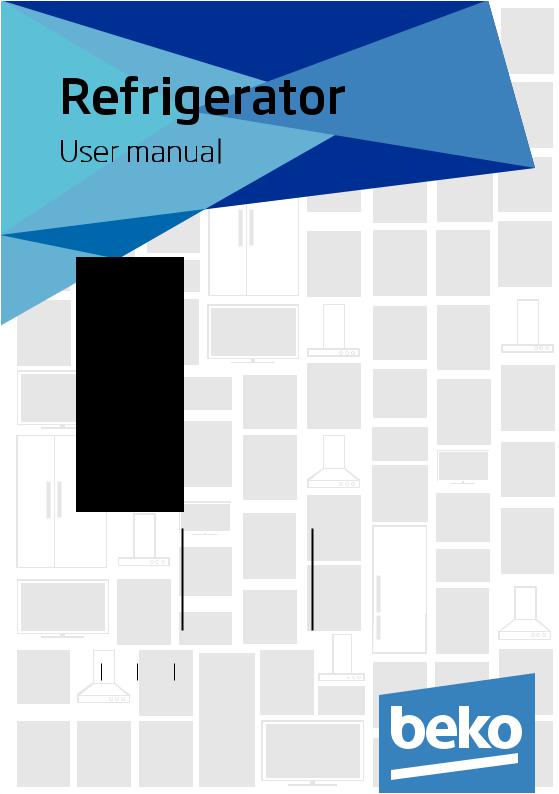
DS 145010 |
RDP6701 |
RDSE450K20W |
DS145010M |
DS145010P |
|
DS145010B |
DS145000S |
|
DS145010S |
RDSE450K11W |
|
EN FR EL |
AR |
|
Please read this user manual first!
Dear Customer,
We hope that your product, which has been produced in modern plants and checked under the most meticulous quality control procedures, will provide you an effective service.
Therefore, read this entire user manual carefully before using the product and keep it as a reference. If you handover the product to someone else, give the user manual as well.
The user manual will help you use the product in a fast and safe way.
•Read the manual before installing and operating the product.
•Make sure you read the safety instructions.
•Keep the manual in an easily accessible place as you may need it later.
•Read the other documents given with the product.
Remember that this user manual is also applicable for several other models. Differences between models will be identified in the manual.
Explanation of symbols
Throughout this user manual the following symbols are used:
CImportant information or useful tips.
AWarning against dangerous conditions for life and property. BWarning against electric voltage.

CONTENTS
1 Your refrigerator |
3 |
2 Important Safety |
|
Warnings |
4 |
Intended use...................................... |
4 |
General safety.................................... |
5 |
For products with a ........................... |
9 |
water dispenser;................................. |
9 |
Child safety........................................ |
9 |
Compliance with WEEE Directive and |
|
Disposing of the Waste Product: ....... |
9 |
Package information........................ |
10 |
HC warning...................................... |
10 |
Things to be done for energy saving.10 |
|
3 Installation |
12 |
Points to be paid attention to when the |
|
relocation of the refrigerator.............. |
12 |
Electrical connection........................ |
12 |
Disposing of the packaging.............. |
13 |
Disposing of your old refrigerator...... |
13 |
Placing and Installation..................... |
13 |
Adjusting the legs............................. |
14 |
Changing the illumination lamp ........ |
14 |
Reversing the doors......................... |
15 |
Reversing the doors......................... |
16 |
Reversing the doors......................... |
17 |
Reversing the doors......................... |
18 |
4 |
Preparation |
19 |
5 |
Using your refrigerator 20 |
|
Thermostat setting button................ |
20 |
|
Defrost............................................. |
20 |
|
Stopping your product..................... |
21 |
|
Making ice........................................ |
21 |
|
Crisper humidity control sliders......... |
22 |
|
Turbo Cooling Fan............................ |
22 |
|
Using the rotary crisper (in some |
|
|
models)............................................ |
23 |
|
6 |
Maintenance and |
|
cleaning |
24 |
|
Protection of plastic surfaces .......... |
24 |
|
7 |
Troubleshooting |
25 |
2 EN
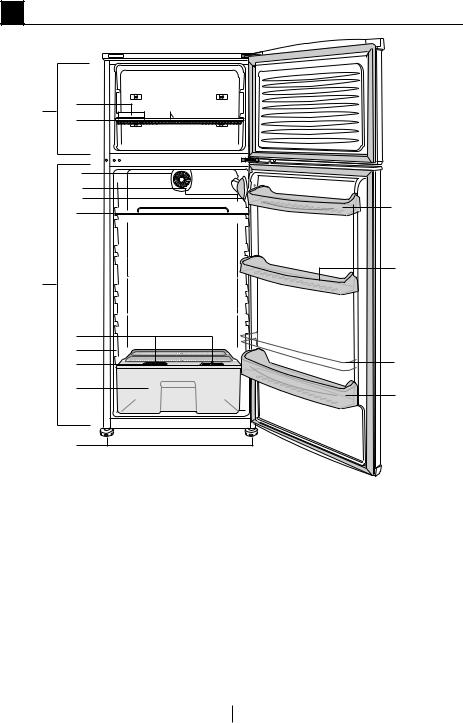
1 Your refrigerator
151
*2
4*3 |
|
5 |
*12 |
*6 |
|
|
13 |
166 


 *12
*12
6 

7
8
9
*10
11
1. |
Ice cube tray |
9. |
Salad crisper |
|
2. |
Freezer shelf |
10. |
Adjustable legs |
|
3. |
Interior light |
11. |
Door shelf |
|
4. |
Thermostat knob |
12. |
Egg tray |
|
5. |
Fridge compartment shelves |
13. |
Bottle shelf |
|
6. |
Defrost water collection channel |
14.Key |
||
|
- Drain tube |
15.Freezer compartment |
||
7. |
Crisper humidity controls |
|||
16.Fridge compartment |
||||
8. |
Crisper cover |
|||
* OPTIONAL |
||||
|
|
|||
*
*14
CFigures that take place in this instruction manual are schematic and may not correspond exactly with your product. If the subject parts are not included in the product you have purchased, then it is valid for other models.
3 EN

2 Important Safety Warnings
Please review the following information. Failure to observe this information may cause injuries or material damage. Otherwise, all warranty and reliability commitments will become invalid.
Original spare parts will be provided for 10 years, following the product purchasing date.
Intended use
WARNING:
Keep ventilation openings, in the
Aappliance enclosure or in the built-in structure, clear of obstruction.
WARNING:
Do not use mechanical devices or other means
Ato accelerate the defrostingprocess, other than those recommended by the manufacturer.
4
WARNING:
ADo not damage the refrigerant circuit.
WARNING:
Do not use electrical appliances inside the food storage
Acompartments of the appliance, unless they
are of the type recommended by the manufacturer.
WARNING:
Do not store explosive
Asubstances such as aerosol cans with a flammable propellant in this appliance.
This appliance is intended to be used in household and similar applications such as
– staff kitchen areas in shops, offices and other working environments;
– farm houses and by clients in hotels, motels and other residential type environments;
EN

–bed and breakfast type environments;
–catering and similar
non-retail applications.
General safety
•When you want to dispose/scrap the product, we recommend you to consult the authorized service
in order to learn the required information and authorized bodies.
•Consult your authorized service for all your questions and problems related to the refrigerator. Do not intervene or let someone intervene to the refrigerator without notifying the authorised services.
•For products with a freezer compartment; Do not eat cone ice cream and ice cubes immediately after you take them out of the freezer compartment! (This may cause frostbite in your mouth.)
•For products with a freezer compartment; Do not put bottled and canned liquid
beverages in the freezer compartment. Otherwise, these may burst.
•Do not touch frozen food by hand; they may stick to your hand.
•Unplug your refrigerator before cleaning or defrosting.
•Vapor and vaporized cleaning materials should never be used in cleaning and defrosting processes of your refrigerator. In such cases, the vapor may get in contact with the electrical parts and cause short circuit or electric shock.
•Never use the parts on your refrigerator such as the door as a means of support or step.
•Do not use electrical devices inside the refrigerator.
•Do not damage the parts, where the refrigerant is circulating, with drilling or cutting tools. The refrigerant that might blow out when the gas channels
5 EN

of the evaporator, pipe extensions or surface coatings are punctured causes skin irritations and eye injuries.
•Do not cover or block the ventilation holes on your refrigerator with any material.
•Electrical devices must be repaired by only authorised persons. Repairs performed by incompetent persons create a risk for the user.
•In case of any failure or during a maintenance or repair work, disconnect your refrigerator’s mains supply by either turning off the relevant fuse
or unplugging your appliance.
•Do not pull by the cable when pulling off the plug.
•Ensure highly alcoholic beverages are stored securely with the lid fastened and placed upright.
•Never store spray cans containing
flammable and explosive substances in the refrigerator.
•Do not use mechanical devices or other means to accelerate the defrosting process, other than those recommended by the manufacturer.
•This product is not intended to be used by persons with physical, sensory or mental disorders or unlearned or inexperienced people (including children) unless they are attended by a person who will
be responsible for their safety or who will instruct them accordingly for use of the product
•Do not operate a damaged refrigerator. Consult with the service agent if you have any concerns.
•Electrical safety of your refrigerator shall be guaranteed only if the earth system in your house complies with standards.
•Exposing the product to rain, snow, sun and wind is dangerous with respect to electrical
6 EN

safety.
•Contact authorized service when there is a power cable damage to avoid danger.
•Never plug the refrigerator into the wall outlet during installation. Otherwise, risk of death or serious injury may arise.
•This refrigerator is intended for only storing food items. It must not be used for any other purpose.
•Label of technical specifications is located on the left wall inside the refrigerator.
•Never connect your refrigerator to electricitysaving systems; they may damage the refrigerator.
•If there is a blue light on the refrigerator, do not look at the blue light with optical tools.
•For manually controlled refrigerators, wait for at least 5 minutes to start the refrigerator after power failure.
•This operation manual should be handed in to the new owner of the product when it is given to others.
•Avoid causing damage on power cable when transporting the refrigerator. Bending cable may cause fire. Never place heavy objects on power cable. Do not touch the plug with wet hands when plugging the product
•Do not plug the refrigerator if the wall outlet is loose.
•Water should not be sprayed on inner or outer parts of the product for safety purposes.
•Do not spray substances containing inflammable gases such as propane gas near the refrigerator to avoid fire and explosion risk.
7 EN

•Never place containers filled with water on top of the refrigerator; in the event of spillages, this may cause electric shock or fire.
•Do not overload the refrigerator with food. If overloaded, the food
items may fall down and hurt you and damage refrigerator when you open the door.
•Never place objects on top of the refrigerator; otherwise, these objects may fall down when you open or close the refrigerator’s door.
•As they require a precise temperature, vaccines, heat-sensitive medicine and scientific materials and etc. should not be kept in the refrigerator.
•If not to be used for a long time, refrigerator should be unplugged. A possible problem in power cable may cause fire.
•Refrigerator may move if adjustable legs are not properly secured on the
floor. Properly securing adjustable legs on the floor can prevent the refrigerator to move.
•When carrying the refrigerator, do not hold it from door handle. Otherwise, it may be snapped.
•When you have to place your product next to another refrigerator or freezer, the distance between devices should be at least 8cm. Otherwise, adjacent side walls may be humidified.
•The product shall never be used while the compartment which is located at the top or back of your product and in which electronic boards are available (electronic board box cover) (1) is open.
8 EN
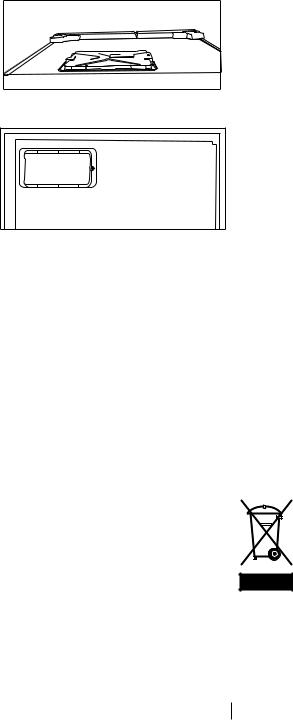
|
water hammer effect in |
|
|
your installation. |
|
1 |
• Do not install on the |
|
|
hot water inlet. Take |
|
|
precautions against |
|
|
of the risk of freezing |
|
|
of the hoses. Water |
|
|
temperature operating |
|
1 |
interval shall be 33°F |
|
|
(0.6°C) minimum |
|
|
and 100°F (38°C) |
|
For products with a |
maximum. |
|
• Use only potable water. |
||
water dispenser; |
||
Child safety |
||
• Pressure for cold water |
||
• If the door has a lock, |
||
inlet shall be maximum |
||
90 psi (6.2 bar). If your |
the key should be kept |
|
away from reach of |
||
water pressure exceeds |
||
children. |
||
80 psi (5.5 bar), use a |
||
• Children must be |
||
pressure limiting valve |
||
supervised to prevent |
||
in your mains system. If |
||
them from tampering |
||
you do not know how |
||
with the product. |
||
to check your water |
||
Compliance with WEEE |
||
pressure, ask for the |
||
Directive and Disposing of |
||
help of a professional |
the Waste Product: |
|
plumber. |
|
|
• If there is risk of water |
This product complies |
|
hammer effect in your |
with EU WEEE Directive |
|
(2012/19/EU). This product |
||
installation, always |
||
bears a classification |
||
use a water hammer |
symbol for waste electrical |
|
prevention equipment |
and electronic equipment |
|
in your installation. |
(WEEE). |
|
|
||
Consult Professional |
|
|
plumbers is you are not |
|
|
sure that there is no |
|
9 EN

This product has been manufactured with high quality parts and materials which can be reused and are suitable for recycling. Therefore, do not dispose the product with normal domestic waste at the end of its service life. Take it to a collection point for the recycling of electrical and electronic equipment. Please consult your local authorities
to learn the nearest collection point. Help protect the environment and natural resources by recycling used products. For children’s safety, cut the power cable and break the locking mechanism of the door, if any, so
that it will be non-functional before disposing of the product.
Package information
Packaging materials of the product are manufactured from recyclable materials in accordance with our National Environment Regulations. Do not dispose of the packaging materials together with the domestic or other wastes. Take them to the packaging material collection points designated by the local authorities.
Do not forget...
Any recycled substance is an indispensable matter for nature and our national asset wealth.
If you want to contribute to the re-evaluation of the packaging materials, you can consult to your environmentalist organizations or the municipalities where you are located.
HC warning
If your product's cooling system contains R600a:
This gas is flammable. Therefore, pay attention to not damaging the cooling system and piping during usage and transportation. In the event of damage, keep your product away from potential fire sources that can cause the product catch a fire and ventilate the room in which the unit is placed.
Ignore this warning if your product's cooling system contains R134a.
Type of gas used in the product is stated in the type label which is on the left wall inside the refrigerator.
Never throw the product in fire for disposal.
Things to be done for energy saving
•Do not leave the doors of your refrigerator open for a long time.
•Do not put hot food or drinks in your refrigerator.
•Do not overload your refrigerator so that the air circulation inside of it is not prevented.
•Do not install your refrigerator under direct sunlight or near heat emitting appliances such as ovens, dishwashers or radiators. Keep your refrigerator at least 30cm away from heat emitting sources and at least 5cm from electrical ovens.
•Pay attention to keep your food in closed containers.
10 EN

•For products with a freezer compartment; You can store maximum amount of food items in the freezer when you remove the shelf or drawer of the freezer. Energy consumption value stated for your refrigerator has been determined
by removing freezer shelf or drawer and under maximum load. There is no harm to use a shelf or drawer
according to the shapes and size of food to be frozen.
•Thawing frozen food in fridge compartment will both provide energy saving and preserve the food quality.
11 EN
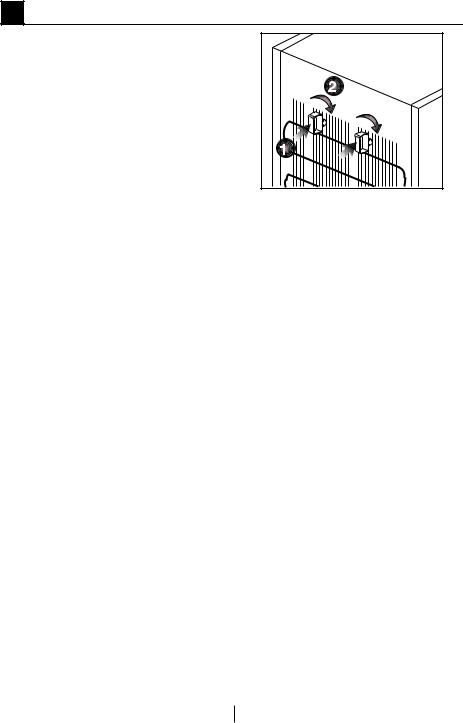
3 Installation
B In case the information which are given in the user manual are not taken into account, manufacturer will not assume
any liability for this.
Points to be paid attention to when the relocation of the refrigerator
1.Your refrigerator should be unplugged.Before transportation of your refrigerator, it should be emptied and cleaned.
2.Before it is re-packaged, shelves, accessories, crisper, etc. inside your refrigerator should be fixed with adhesive tape and secured against impacts. Package should be bound with a thick tape or sound ropes and the transportation rules on the package should be strictly observed.
3.Original packaging and foam materials should be kept for future transportations or moving.
Before you start the refrigerator,
Check the following before you start to use your refrigerator:
1.Attach 2 plastic wedges as illustrated below. Plastic wedges are intended to keep the distance which will ensure the air circulation between your refrigerator and the wall. (The picture is drawn up as a representation and it is not identical with your product.)
2.Clean the interior of the refrigerator as recommended in the “Maintenance and cleaning” section.
3.Connect the plug of the refrigerator to the wall socket. When the fridge door is opened, fridge internal lamp will turn on.
4.When the compressor starts to operate, a sound will be heard. The liquid and gases sealed within the refrigeration system may also give rise to noise, even if the compressor is not running and this is quite normal.
5.Front edges of the refrigerator may feel warm. This is normal. These areas are designed to be warm to avoid condensation.
Electrical connection
Connect your product to a grounded socket which is being protected by a fuse with the appropriate capacity.
Important:
The connection must be in compliance with national regulations.
•The power plug must be easily accessible after installation.
•Electrical safety of your refrigerator shall be guaranteed only if the earth system in your house complies with standards.
•The voltage stated on the label located at left inner side of your product should be equal to your network voltage.
•Extension cables and multi plugs must not be used for connection.
12 EN

B A damaged power cable must be replaced by a qualified electrician.
B Product must not be operated before it is repaired! There is the risk of
electric shock!
Disposing of the packaging
The packing materials may be dangerous for children. Keep the packing materials out of the reach of children or dispose of them by
classifying them in accordance with the waste instructions stated by your local authorities. Do not throw away with regular house waste, throw away on packaging pick up spots designated by the local authorities.
The packing of your refrigerator is produced from recyclable materials.
Disposing of your old refrigerator
Dispose of your old refrigerator without giving any harm to the environment.
•You may consult your authorized dealer or waste collection center of your municipality about the disposal of your refrigerator.
Before disposing of your refrigerator, cut out the electric plug and, if there are any locks on the door, make them inoperable in order to protect children against any danger.
Placing and Installation
A If the entrance door of the room where the refrigerator will be installed is not wide enough for the refrigerator to pass through, then call the authorized service to have them remove the doors of your refrigerator and pass it sideways through the door.
1.Install your refrigerator to a place that allows ease of use.
2.Keep your refrigerator away from heat sources, humid places and direct sunlight.
3.There must be appropriate air ventilation around your refrigerator in order to achieve an efficient operation. If the refrigerator is to be placed in a recess in the wall, there must be at least 5 cm distance with the ceiling and at least 5 cm with the wall. Do not place your product on the materials such as rug or carpet.
4.Place your refrigerator on an even floor surface to prevent jolts.
13 EN
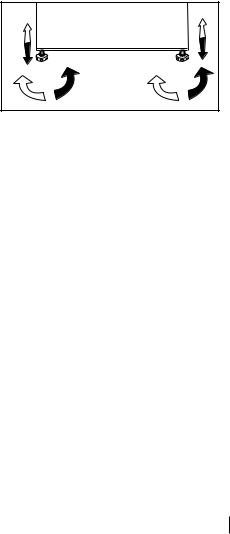
Adjusting the legs
If your refrigerator is unbalanced;
You can balance your refrigerator by turning its front legs as illustrated in the figure. The corner where the leg exists is lowered when you turn in the direction of black arrow and raised when you turn in the opposite
direction. Taking help from someone to slightly lift the refrigerator will facilitate this process.
Changing the illumination lamp
To change the Bulb/LED used for illumination of your refrigerator, call your AuthorisedService.
The lamp(s) used in this appliance is not suitable for household room
illumination. The intended purpose of this lamp is to assist the user to place foodstuffs in the refrigerator/freezer
in a safe and comfortable way.The lamps used in this appliance have to withstand extreme physical conditions such as temperatures below -20 °C.
(only chest and upright freezer)
14 EN
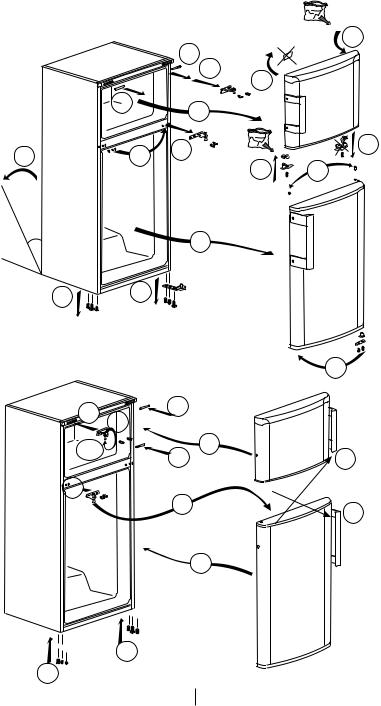
Reversing the doors
Proceed in numerical order.
4 5
4 2
7 |
6 |
1 |
|
 10
10
10
|
11 |
12 |
13 |
45°
3
8 9
|
|
14 |
|
18 |
19 |
|
|
17 |
|
||
180° |
19 |
22 |
|
24 |
|||
|
|||
23 |
21 |
|
|
|
24 |
||
|
|
||
|
|
20 |
 16 15
16 15 

15 EN
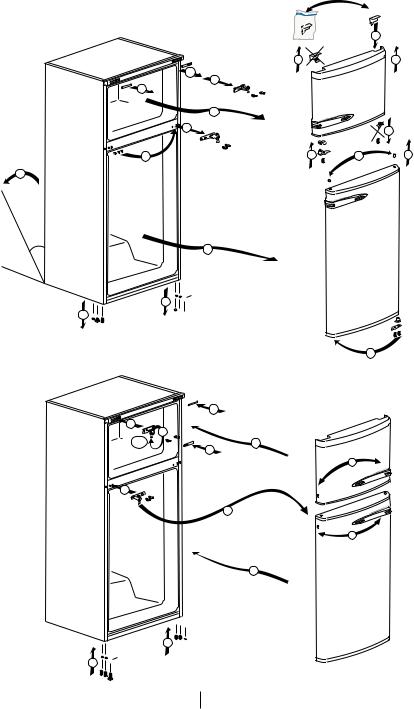
Reversing the doors
Proceed in numerical order.
10
4
5
4
|
2 |
|
1 |
6 |
12 |
7
10
10
 11
11
13 |
12 |
45 °
3
9  8
8 





14
19
18
180° |
17 |
|
1 |
22 |
|
|
|
24
23
2
24
2
16 


15
16 EN
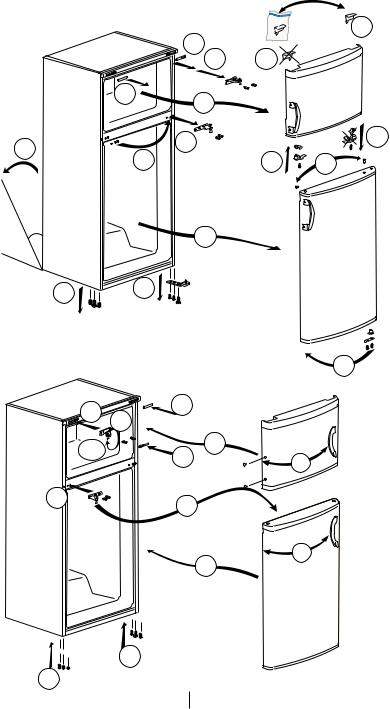
Reversing the doors
Proceed in numerical order.
10
4 |
5 |
10 |
42
7 |
|
1 |
11 |
|
6 |
|
|||
12 |
13 |
|||
|
45°
3
8 9
14
18 |
19 |
|
|
17 |
|
||
180° |
19 |
22 |
|
24 |
|||
|
23 |
21 |
|
|
|
24 |
|
20 |
 16 15
16 15 

17 EN
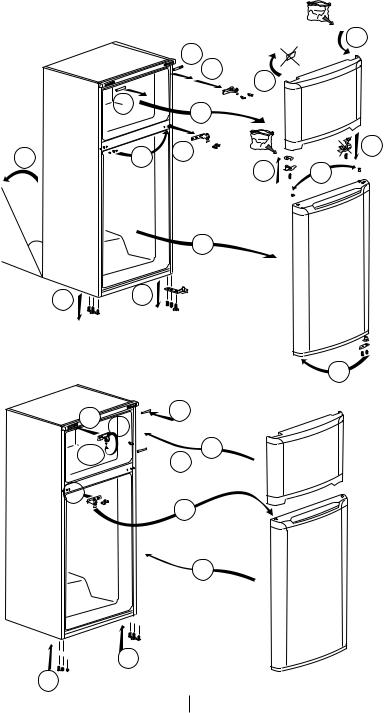
Reversing the doors
Proceed in numerical order.
4 5
4 2
7 |
6 |
1 |
|
 10
10
10
|
11 |
12 |
13 |
45°
3
8 9
14
18 |
19 |
17 |
180° 



 19 22
19 22
23
21
20
 16 15
16 15 

18 EN

4 |
Preparation |
|
• |
Your cooler/freezer should be |
not thaw thanks to its Advanced |
installed at least 30 cm away from |
Electronic Temperature Control |
|
heat sources such as hobs, ovens, |
System. For the first installation, the |
|
central heater and stoves and at least |
product should NOT be placed under |
|
5 cm away from electrical ovens and |
low ambient temperatures. This is |
|
should not be located under direct |
because the freezer cannot go down |
|
sunlight. |
to standard operation temperature. |
|
• Please make sure that the interior |
When reaching continuous operation, |
|
of your cooler/freezer is cleaned |
the product can be moved to |
|
thoroughly. |
another place. Thus, later you can |
|
• If two coolers are to be installed side |
place your product in the garage |
|
by side, there should be at least 2 cm |
or an unheated room without the |
|
distance between them. |
concern of causing frozen food to |
|
• When you operate your cooler/freezer |
get rotten. However, it is likely that |
|
for the first time, please observe the |
above mentioned low temperatures |
|
following instructions during the initial |
may cause the freezing of the food in |
|
six hours. |
the fridge compartment; thus, please |
|
• Its door should not be opened |
consume the food items in the fridge |
|
frequently. |
in a controlled way as needed. When |
|
• It must be operated empty without |
ambient temperature goes back |
|
placing any food in it. |
to normal, you may change button |
|
• Do not unplug your cooler/freezer. |
setting according to your need. |
|
If a power failure occurs out of your |
• If the ambient temperature is below |
|
control, please see the warnings in |
0°C, the food in fridge compartment |
|
the “Recommended solutions for the |
will freeze. Therefore, we recommend |
|
problems” section. |
not using the fridge compartment |
|
• The baskets/drawers that are |
in such low ambient temperatures. |
|
provided with the chill compartment |
You may continue to use the freezer |
|
must always be in use for low energy |
compartment as usual. |
|
consumption and for better storage |
• In some models, the instrument panel |
|
conditions. |
automatically turns off 5 minutes |
|
• Food contact with the temperature |
after the door has closed. It will |
|
sensor in the freezer compartment |
be reactivated when the door has |
|
may increase energy consumption of |
opened or pressed on any key. |
|
the appliance. Thus any contact with |
• Due to temperature change as a |
|
the sensor(s) must be avoided. |
result of opening/closing the product |
|
• This product has been designed to |
door during operation, condensation |
|
function at ambient temperatures |
on the door/body shelves and the |
|
up to 43 °C (90 SDgrF). Even if the |
glass containers is normal. |
|
ambient temperature falls to -15 |
|
|
°C, frozen food in the freezer does |
|
|
19 EN
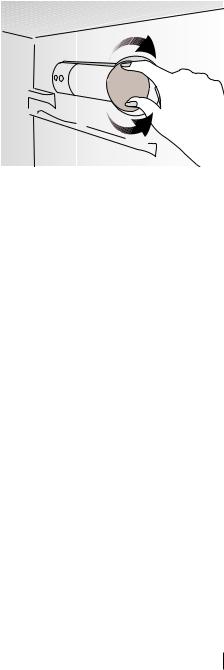
|
|
|
Using your refrigerator |
|
|||||||||
5 |
|
|
|||||||||||
|
|
|
|
|
|
|
|
|
|
|
|
|
|
|
|
|
Thermostat setting button |
Defrost |
|||||||||
|
|
|
|
|
|
|
|
|
|
|
|
||
|
|
|
|
|
|
|
|
|
|
|
|
Fridge compartment performs full- |
|
|
|
|
|
|
|
|
|
|
|
|
|
||
|
|
|
|
|
|
|
|
|
|
|
|
automatic defrosting. Water resulting |
|
|
|
|
|
|
|
|
|
|
|
|
|
from the defrosting passes from the |
|
|
|
|
|
|
|
|
|
|
|
|
|
water collection groove and flows |
|
|
|
|
|
|
|
|
|
|
|
|
|
into the evaporator through the drain |
|
|
|
|
|
|
|
|
|
|
|
|
|
pipe and evaporates here by itself. |
|
|
|
|
|
|
|
|
|
|
|
|
|
||
|
|
|
|
|
|
|
|
|
|
|
|
||
|
|
|
|
|
|
|
|
|
|
|
|
• Deep freezer compartment does not |
|
|
|
|
|
|
|
|
|
|
|
|
|
||
|
|
|
|
|
|
|
|
|
|
|
|
perform automatic defrosting in order |
|
|
|
|
|
|
|
|
|
|
|
|
|
||
|
|
|
|
|
|
|
|
|
|
|
|
to prevent decaying of the frozen |
|
|
|
|
|
|
|
|
|
|
|
|
|
food. |
|
|
|
|
|
|
|
|
|
|
|
|
|
• Frost formation in the freezer |
|
The interior temperature of your |
compartment must be defrosted |
||||||||||||
every 6 months. It is recommended |
|||||||||||||
refrigerator changes for the following |
|||||||||||||
to defrost the ice when the deep |
|||||||||||||
reasons; |
|||||||||||||
freezer compartment is not filled too |
|||||||||||||
• |
Seasonal temperatures, |
||||||||||||
much or is empty. |
|||||||||||||
• Frequent opening of the door and |
• To do this, wrap the frozen food |
|
leaving the door open for long |
||
by paper and keep them in the |
||
periods, |
||
coolest place possible or in another |
||
• Food put into the refrigerator |
||
refrigerator if available. |
||
without cooling down to the room |
||
• Stop your refrigerator by means of the |
||
temperature, |
||
temperature setting button or unplug |
||
• The location of the refrigerator in the |
||
the power cord from the outlet. You |
||
room (e.g. exposing to sunlight). |
||
can place a container filled with hot |
||
• You may adjust the varying interior |
||
water into the freezer compartment |
||
temperature due to such reasons |
||
or leave the door of the freezer |
||
by using the thermostat. Numbers |
||
compartment open in order to hasten |
||
around the thermostat button |
||
the defrosting. |
||
indicates the cooling degrees. |
||
• Remove the water that accumulates |
||
• If the ambient temperature is higher |
||
in the lower container of the freezer |
||
than 32°C, turn the thermostat |
||
compartment with an absorbent cloth |
||
button to maximum position. |
||
or sponge. |
||
• If the ambient temperature is lower |
||
• Dry the freezer compartment |
||
than 25°C, turn the thermostat |
||
completely and return the |
||
button to minimum position. |
||
temperature setting button to its |
||
|
||
|
previous position. |
20 EN
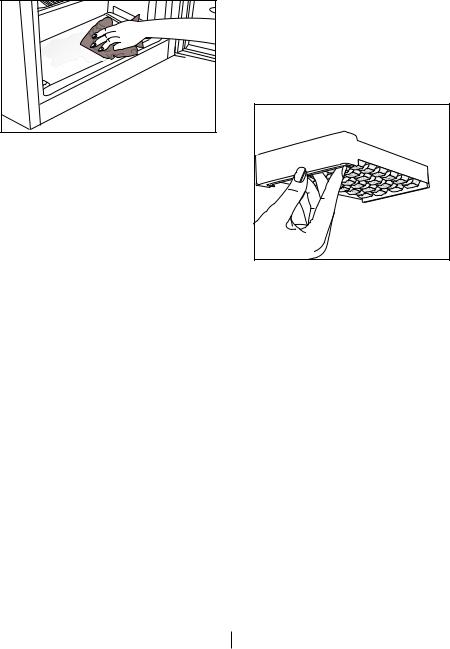
• Operate your refrigerator for 2 hours while it is empty and its doors are closed before replacing your food into the deep freezer.
Making ice
*optional
Fill the ice container with water and place it into the freezer compartment. Your ice will be ready approximately in two hours.
You can remove the ice in the ice container by removing it from the freezer and twisting it.
Stopping your product
If your thermostat is equipped with “0” position:
- Your product will stop operating when you turn the thermostat button to “0” (zero) position. Your product will not start unless to you turn the thermostat button to position “1” or one of the other positions again.
If your thermostat is equipped with “min” position:
- Unplug your product to stop it.
21 EN

Crisper humidity control sliders
Using the crisper humidity control sliders
Crisper of your refrigerator is designed specially to keep your vegetables fresh without loosing their humidity. Cold air circulates basically around the crisper and the amount of the cold air passing through the crisper is controlled by the sliders on the front side of the crisper cover.
You can adjust the humidity control sliders to a suitable position according to the humidity and cooling condition of your food in the crisper.
If you want your food in the crisper to cool more, open the holes of the humidity control sliders and if you want them to cool less and keep their humidity for a longer time, close the holes.
Turbo Cooling Fan
“Turbo cooling fan is designed to ensure homogenous distribution and circulation of the cold air inside your refrigerator. Operation time of the turbo cooling fan may vary depending on the properties of your product. While the turbo fan works only with the compressor in some products, the control system determines its operation time in some products
in accordance with the cooling requirement. This situation is explained on a separate warning and information label attached on the refrigerator in products equipped with turbo fans running under different conditions than the compressor.”
* OPTIONAL
22 EN
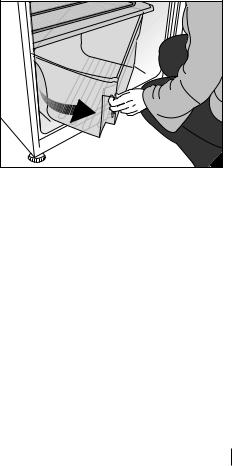
Using the rotary crisper (in some models)
The crisper of your refrigerator which opens with a rotating movement is designed specially to provide ease of usage and allow you to store more vegetables and fruits (large volume) you buy during large shopping.
When you grab and pull the handle on the lower left hand side of the crisper, it will rotate from left to right and open easily. The separator in the crisper will allow you to separate the vegetables and fruits according to their types and prevent them from crushing.
23 EN

6 Maintenance and cleaning
ANever use gasoline, benzene or similar substances for cleaning purposes.
BWe recommend that you unplug the appliance before cleaning.
BNever use any sharp abrasive instrument, soap, household cleaner, detergent and wax polish for cleaning.
CUse lukewarm water to clean the cabinet of your refrigerator and wipe it dry.
CUse a damp cloth wrung out in a solution of one teaspoon of
bicarbonate of soda to one pint of water to clean the interior and wipe it dry.
BMake sure that no water enters the lamp housing and other electrical items.
BIf your refrigerator is not going to be used for a long period of time, unplug the power cable, remove all food, clean it and leave the door ajar.
CCheck door seals regularly to ensure they are clean and free from food particles.
ATo remove door racks, remove all the contents and then simply push the door rack upwards from the base.
ANever use cleaning agents or water that contain chlorine to clean the outer surfaces and chromium coated parts of the product. Chlorine causes corrosion on such metal surfaces.
ADo not use sharp, abrasive tools, soap, household cleaning agents, detergents, kerosene, fuel oil, varnish etc. to prevent removal and deformation of the prints on the plastic part. Use lukewarm water and a soft cloth for cleaning and then
wipe it dry.
Protection of plastic surfaces
CDo not put the liquid oils or oil-cooked meals in your refrigerator in unsealed containers as they damage the plastic surfaces of your refrigerator. In case of spilling or smearing oil on the plastic surfaces, clean and rinse the relevant part of the surface at once with warm water.
24 EN
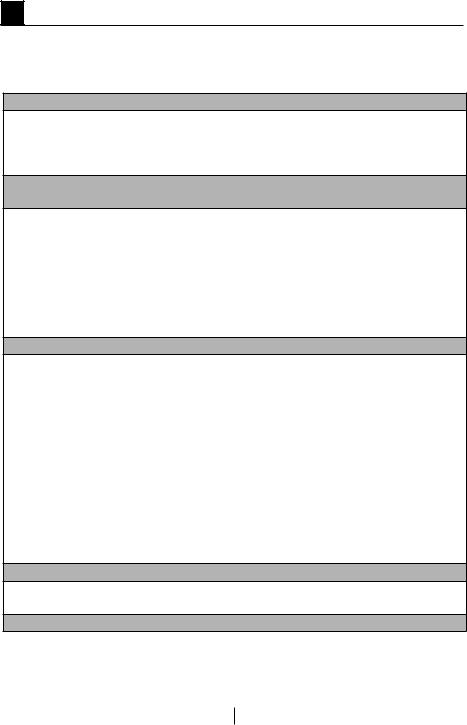
7 Troubleshooting
Please review this list before calling the service. It will save your time and money. This list includes frequent complaints that are not arising from defective workmanship or material usage. Some of the features described here may not exist in your product.
The refrigerator does not operate.
•The plug is not inserted into the socket correctly. >>>Insert the plug into the socket securely.
•The fuse of the socket which your refrigerator is connected to or the main fuse have blown out. >>>Check the fuse.
Condensation on the side wall of the fridge compartment (MULTIZONE, COOL CONTROL and FLEXI ZONE).
•Door has been opened frequently. >>>Do not open and close the door of refrigerator frequently.
•Ambient is very humid. >>>Do not install your refrigerator into highly humid places.
•Food containing liquid is stored in open containers. >>>Do not store food with liquid content in open containers.
•Door of the refrigerator is left ajar. >>>Close the door of the refrigerator.
•Thermostat is set to a very cold level. >>>Set the thermostat to a suitable level.
•Compressor is not running
•Protective thermic of the compressor will blow out during sudden power failures or plug-out plug-ins as the refrigerant pressure in the cooling system of the refrigerator has not been balanced yet. The refrigerator will start running
approximately after 6 minutes. Please call the service if the refrigerator does not startup at the end of this period.
•The fridge is in defrost cycle. >>>This is normal for a full-automatically defrosting refrigerator. Defrosting cycle occurs periodically.
•The refrigerator is not plugged into the socket. >>>Make sure that the plug is fit into the socket.
•Temperature settings are not made correctly. >>>Select the suitable temperature value.
•There is a power outage. >>>Refrigerator returns to normal operation when the power restores.
The operation noise increases when the refrigerator is running.
•The operating performance of the refrigerator may change due to the changes in the ambient temperature. It is normal and not a fault.
The refrigerator is running frequently or for a long time.
25 EN
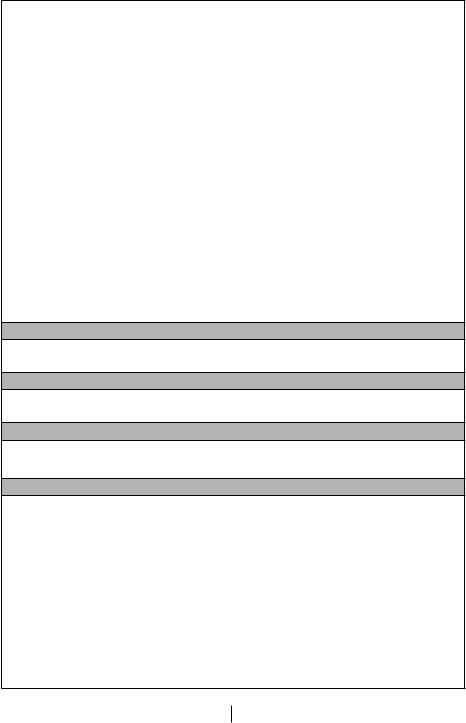
•New product may be wider than the previous one. Larger refrigerators operate for a longer period of time.
•The room temperature may be high. >>>It is normal that the product operates for longer periods in hot ambient.
•The refrigerator might be plugged in recently or might be loaded with food.
>>>When the refrigerator is plugged in or loaded with food recently, it will take longer for it to attain the set temperature. This is normal.
•Large amounts of hot food might be put in the refrigerator recently. >>>Do not put hot food into the refrigerator.
•Doors might be opened frequently or left ajar for a long time. >>>The warm air that has entered into the refrigerator causes the refrigerator to run for longer periods. Do not open the doors frequently.
•Freezer or fridge compartment door might be left ajar. >>>Check if the doors are closed completely.
•The refrigerator is adjusted to a very low temperature. >>>Adjust the refrigerator temperature to a warmer degree and wait until the temperature is achieved.
•Door seal of the fridge or freezer may be soiled, worn out, broken or not properly seated. >>>Clean or replace the seal. Damaged/broken seal causes the refrigerator to run for a longer period of time in order to maintain the current temperature.
Freezer temperature is very low while the fridge temperature is sufficient.
•The freezer temperature is adjusted to a very low value. >>>Adjust the freezer temperature to a warmer degree and check.
Fridge temperature is very low while the freezer temperature is sufficient.
•The fridge temperature is adjusted to a very low value. >>>Adjust the fridge temperature to a warmer degree and check.
Food kept in the fridge compartment drawers is frozen.
•The fridge temperature is adjusted to a very high value. >>>Adjust the fridge temperature to a lower value and check.
Temperature in the fridge or freezer is very high.
•The fridge temperature is adjusted to a very high value. >>>Fridge compartment temperature setting has an effect on the temperature of the freezer. Change the temperatures of the fridge or freezer and wait until the relevant compartments attain a sufficient temperature.
•Doors are opened frequently or left ajar for a long time. >>>Do not open the doors frequently.
•Door is ajar. >>>Close the door completely.
•The refrigerator is plugged in or loaded with food recently. >>>This is normal. When the refrigerator is plugged in or loaded with food recently, it will take longer for it to attain the set temperature.
•Large amounts of hot food might be put in the refrigerator recently. >>>Do not put hot food into the refrigerator.
26 EN
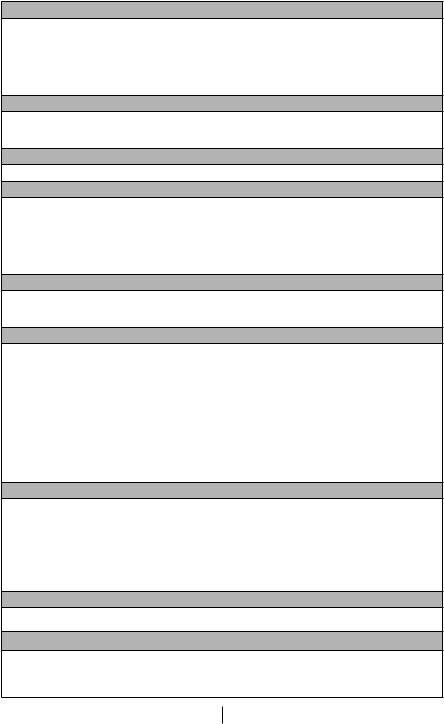
•Vibrations or noise.
•The floor is not level or stable. >>> If the refrigerator rocks when moved slowly, balance it by adjusting its feet. Also make sure that the floor is strong enough to carry the refrigerator, and level.
•The items put onto the refrigerator may cause noise. >>>Remove the items on top of the refrigerator.
There are noises coming from the refrigerator like liquid flowing, spraying, etc.
•Liquid and gas flows occur in accordance with the operating principles of your refrigerator. It is normal and not a fault.
Whistle comes from the refrigerator.
•Fans are used in order to cool the refrigerator. It is normal and not a fault. Condensation on the inner walls of refrigerator.
•Hot and humid weather increases icing and condensation. It is normal and not a fault.
•Doors are opened frequently or left ajar for a long time. >>>Do not open the doors frequently. Close them if they are open.
•Door is ajar. >>>Close the door completely.
Humidity occurs on the outside of the refrigerator or between the doors.
•There might be humidity in the air; this is quite normal in humid weather. When the humidity is less, condensation will disappear.
Bad odour inside the refrigerator.
•No regular cleaning is performed. >>>Clean the inside of the refrigerator regularly with a sponge, lukewarm water or carbonate dissolved in water.
•Some containers or package materials may cause the smell. >>>Use a different container or different brand packaging material.
•Food is put into the refrigerator in uncovered containers. >>>Keep the food in closed containers. Microorganisms spreading out from uncovered containers can cause unpleasant odours.
•Remove the foods that have expired best before dates and spoiled from the refrigerator.
The door is not closing.
•Food packages are preventing the door from closing. >>>Replace the packages that are obstructing the door.
•The refrigerator is not completely even on the floor. >>>Adjust the feet to balance the refrigerator.
•The floor is not level or strong. >>>Make sure that the floor is level and capable to carry the refrigerator.
Crispers are stuck.
• The food is touching the ceiling of the drawer. >>>Rearrange food in the drawer.
If The Surface Of The Product Is Hot.
•High temperatures may be observed between the two doors, on the side panels and at the rear grill while the product is operating. This is normal and does not require service maintenance!
27 EN
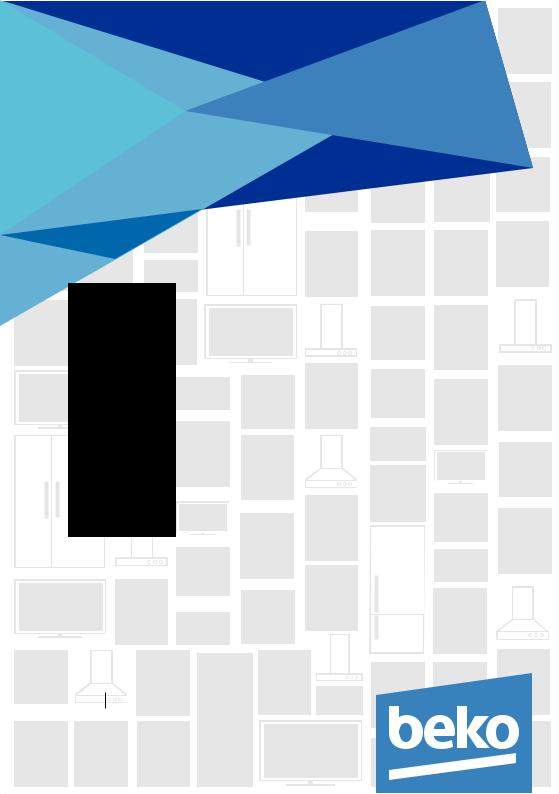
Réfrigérateur |
Manueld'utilisation |
FR |
EWWERQWEW |
Veuillez commencer par lire ce manuel d’utilisation!
Cher client,
Nous espérons que votre produit, qui a été fabriqué dans des usines modernes et vérifié au terme des procédures de contrôle de qualité les plus méticuleuses, vous donnera entière satisfaction.
Veuillez donc lire attentivement l'intégralité de ce manuel avant de commencer à utiliser le produit et conservez-le manuel comme référence. Si vous remettez cet appareil à quelqu'un d'autre, remettez-lui également le manuel d'utilisation.
Ce manuel vous aidera à utiliser votre produit ent toute sécurité et efficacement.
•Lisez le manuel avant d’installer et de faire fonctionner votre produit.
•Veillez à lire les instructions de sécurité.
•Laissez ce manuel dans un endroit facile d’accès car vous pourriez en avoir besoin ultérieurement.
•Lisez également la documentation fournie avec le produit.
N'oubliez pas que le manuel d'utilisation est également valable pour plusieurs autres modèles. Les différences entre les différents modèles seront identifiées dans le manuel.
Explication des symboles
Les symboles ci-dessous sont utilisés dans le manuel d'utilisation:
C
A Avertissement relatif aux situations dangereuses pour la vie et la propriété. B Avertissement relatif à la tension électrique.
